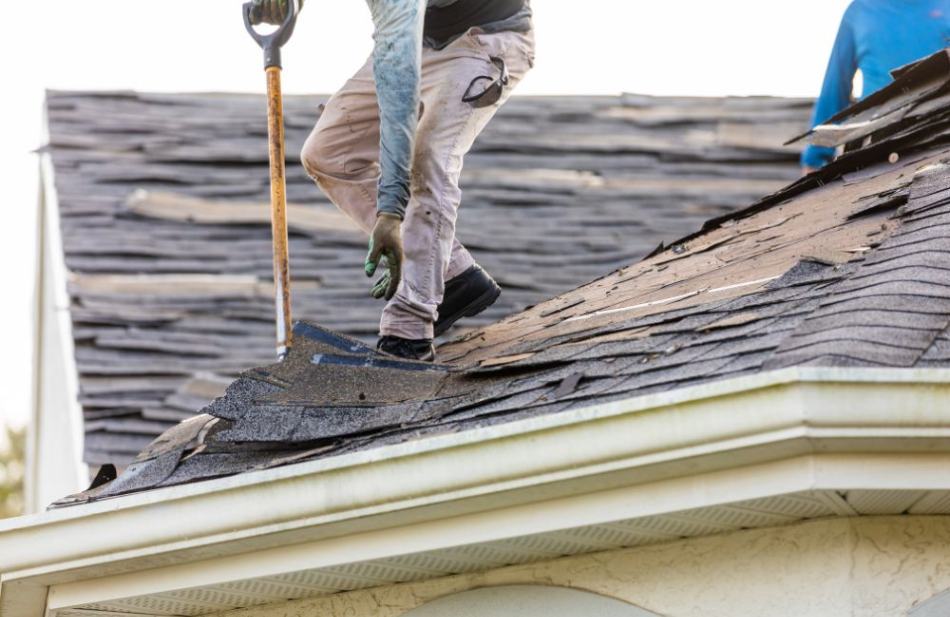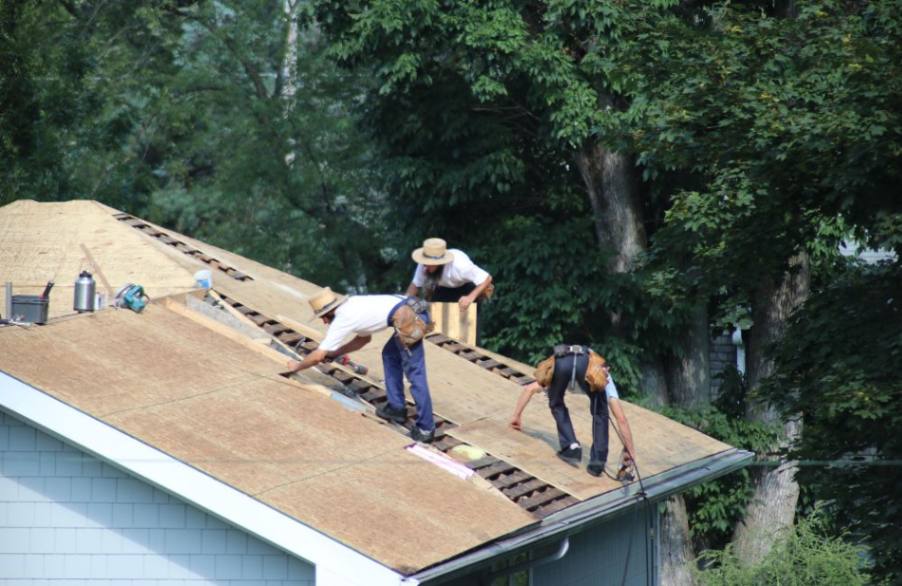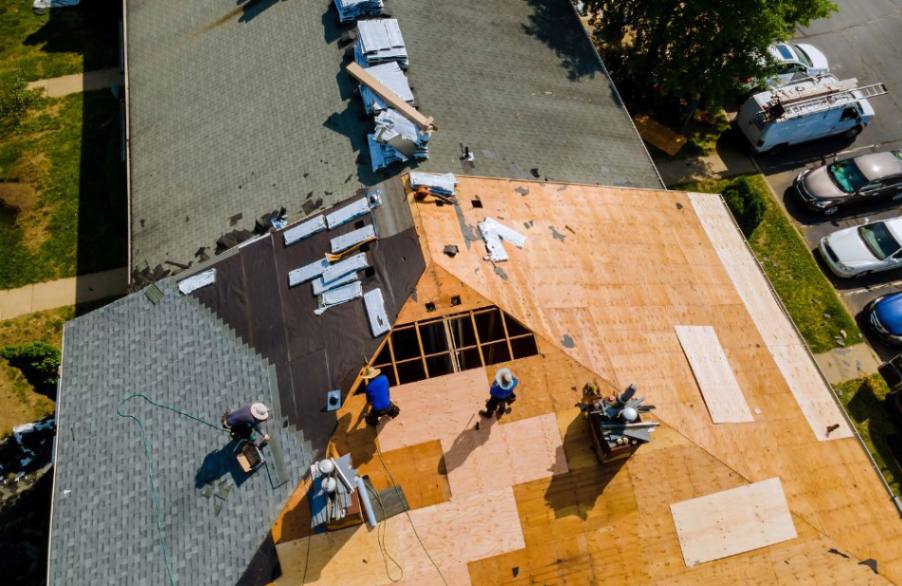Storms can be devastating to homes, and one of the most vulnerable parts of any structure is the roof. Whether it’s pounding rain, gusty winds, hail, or flying debris, even a short-lived storm can inflict lasting damage. The roof, serving as the first line of defense, often takes the brunt of the impact. Recognizing early signs of damage is crucial, and seeking professional roofing services can help prevent minor issues from escalating into major repairs.
Repairing roof damage after a storm can be a substantial financial burden. Homeowners spend an average of $12,404 on hail, wind, or storm damage repairs, with costs typically ranging between $2,718 and $22,144. These figures underscore the importance of timely inspections and maintenance to potentially mitigate high repair expenses.
Here are the five key indicators that homeowners should never ignore. When any of these signs appear, it’s time to call for expert roofing services to assess and repair the damage.
Table of Contents
Key Takeaways
✔ Missing, cracked, or curled shingles expose your roof to water intrusion and require prompt professional attention.
✔ Stains on ceilings or walls suggest roof leaks and hidden moisture damage that only expert roofers can properly trace and repair.
✔ Any visible sagging or unevenness could mean compromised support beams, calling for urgent professional inspection and repairs.
✔ Finding granules after a storm means your shingles are aging prematurely and losing their protective qualities.
✔ Cracked or missing flashing around vents or chimneys allows water to seep in silently, demanding expert sealing and replacement.
1. Shingles Are Missing, Cracked, or Curled
Shingles form the first line of defense against weather elements. When they are compromised after a storm, the risk to the overall roofing system increases significantly. Quick action prevents more extensive and expensive damage, especially in areas with frequent storms. Relying on the best roofing services ensures long-term durability and weather resistance.
Common Post-Storm Shingle Damage Includes:
- Missing Shingles: Often torn off by strong winds, leaving the underlayment exposed.
- Cracked Shingles: Caused by hail impact or fallen debris, creating pathways for water intrusion.
- Curled or Lifted Edges: Typically a result of high winds prying the edges up, breaking the adhesive seal.
- Granule Loss: May not be immediately visible but results in reduced UV protection and surface strength.
Why This Matters:
- Reduced Water Resistance: Damaged shingles allow water to penetrate the layers beneath.
- Accelerated Aging: Shingles with lost granules or curled edges deteriorate much faster.
- Increased Leak Risk: Exposed areas become vulnerable to rainwater infiltration.
When to Call for Help:
- If multiple shingles are missing or show visible signs of curling or cracking, this may indicate widespread stress.
- Contacting professional roofing services allows for a thorough evaluation. Experts assess not only the condition of visible shingles but also the integrity of the layers underneath.
Professional Response:
- Spot Repairs: For limited damage.
- Full Shingle Replacement: For consistent degradation across roof sections.
- Roof Replacement Services: Recommended if the damage is severe or the roof is nearing the end of its life cycle.
2. Water Stains on Ceilings or Walls
Indoor water stains are often the first visible sign that something is wrong with the roof, but they usually indicate a problem that has already started to spread. Timely repairs using the best roofing services help avoid mold infestation, health hazards, and larger structural issues later on.
What Water Stains Can Look Like:
- Brown or Yellow Patches: Often circular or irregular in shape.
- Streaks Down Walls: May appear if the leak has traveled a significant distance.
- Peeling Paint or Bubbling Drywall: Indicates prolonged exposure to moisture.
Hidden Consequences:
- Insulation Damage: Wet insulation loses its effectiveness and can foster mold.
- Electrical Risk: Leaks near wiring or outlets can create fire hazards.
- Structural Rot: Continuous leaks degrade joists, studs, and ceiling panels.
Why Professionals Are Essential:
- Water can travel unpredictably through walls, attic spaces, and insulation. Pinpointing the source without experience can lead to missed damage.
- Professional roofing services use:
- Infrared Cameras to detect moisture.
- Moisture Meters to assess water saturation.
- Visual Inspections to identify breached flashing or shingle failures.
- Infrared Cameras to detect moisture.
Appropriate Fixes Include:
- Sealant Application: To fix minor breaches.
- Flashing or Shingle Repair: If the leak source is around penetrations or roof valleys.
- Roof Replacement Services: If repeated leaks indicate systemic roofing failure.
3. Sagging Roof or Visible Structural Deformities
A sagging roof should never be ignored. Unlike surface issues, this symptom often points to internal compromise and demands urgent professional attention. Relying on roofing services ensures accurate diagnosis and safe remediation. Experts offering roof installation services can rebuild affected sections to meet current safety codes and future storm resistance.
Early Warning Signs:
- Noticeable Dip in the Roofline: Especially around the center of the roof.
- Uneven Appearance from the Street: Can indicate internal frame damage.
- Soft or Bouncy Feel When Walking on the Roof: Suggests that the decking or supports are weakened.
What Causes a Sagging Roof Post-Storm:
- Trapped Moisture: Soaked wood loses strength and begins to sag.
- Rotting Joists or Rafters: From long-term water infiltration.
- Heavy Water or Snow Accumulation: Often due to clogged gutters or poor drainage.
- Damaged Connectors: Storm impact may loosen nails or brackets holding the structure together.
Why DIY Isn’t Safe:
- Sagging areas may be structurally unsound and collapse under weight.
- Professional inspectors understand load distribution and have the tools to test the roof’s strength without risking injury or further damage.
How Professional Roofing Contractors Respond:
- Structural Assessment: To measure the extent of bowing or sinking.
- Reinforcement: Adding supports or replacing damaged beams.
- Decking Replacement: If the plywood or sheathing is compromised.
- Roof Replacement Services: In severe cases where structural components are beyond repair.

4. Granule Accumulation in Gutters or Around the Foundation
Granules are a critical component of asphalt shingles. They serve multiple functions—from protecting shingles from harmful UV rays to aiding in fire resistance and water deflection. A timely inspection ensures that minor degradation doesn’t evolve into major failure. Trustworthy roofing services help preserve the lifespan and weather resilience of the entire roof.
What Granule Loss Looks Like:
- Sandy Debris in Gutters: Appears after a storm, resembling coarse black or gray sand.
- Sediment at Downspout Exits: Granules washed out during rainfall often collect at the base of gutter systems.
- Bare Patches on Shingles: Shiny or smooth areas on shingles can indicate granule erosion.
Why It Happens:
- Hail Impact: Granules are knocked loose on contact.
- Wind-Driven Rain: Water under high pressure dislodges surface particles.
- Abrasion from Debris: Falling branches and flying objects can scrape away the granular layer.
Why It Matters:
- Accelerated Aging: Shingles deteriorate rapidly without granules, becoming brittle and more prone to cracking.
- Loss of UV Protection: Direct sun exposure leads to thermal expansion and contraction, weakening shingle integrity.
- Increased Water Penetration Risk: Bare shingles are more porous, allowing water to reach the underlayment.
What to Do:
- Monitor Gutter Sediment: After any significant storm, check gutters and splash blocks for buildup.
- Call for a Roof Inspection: Providers of professional roofing services can assess whether the granule loss is surface-level or symptomatic of deeper damage.
- Evaluate Overall Shingle Condition: Contractors determine if spot repairs are sufficient or if roof replacement services are needed.
Professional Solutions:
- Targeted Repairs: Replace affected shingles if damage is localized.
- Full Roof Installation Services: Recommended when granule loss is uniform and widespread across the roof surface.
5. Flashing and Sealant Damage Around Roof Penetrations
Roof flashing and sealants play a crucial role in waterproofing the most vulnerable points of a roof. These components protect the joints and seams where the roof intersects with chimneys, skylights, dormers, and vents. Addressing flashing issues is often a critical step in post-storm recovery. Trusted contractors offering the best roofing services ensure that the entire roof system—not just the visible surface—is watertight and storm-ready.
Common Storm-Related Flashing Issues:
- Lifted or Bent Flashing: Wind can catch exposed edges and pull them away from the surface.
- Cracks in Sealant: Temperature shifts and hail impact may crack caulk or adhesive materials.
- Missing or Dislodged Pieces: Flashing torn off completely during high winds or debris strikes.
Consequences of Damaged Flashing:
- Silent Water Intrusion: Leaks around flashing may go undetected for weeks, causing gradual but severe rot.
- Structural Weakening: Moisture near chimneys or vents can deteriorate framing and drywall.
- Mold Growth in Hidden Areas: Persistent moisture promotes fungal growth in attic spaces and wall cavities.
Signs to Watch For:
- Water Spots Around Skylights: Indicate compromised flashing seals.
- Interior Leaks During Heavy Rain: Especially around fireplaces or vent pipes.
- Visible Gaps Around Roof Fixtures: Detachment or separation at flashing points.
Why Call Roofing Professionals:
- Detailed Flashing Assessment: Only trained providers of professional roofing services can identify flashing failures that aren’t obvious from the ground.
- Long-Term Solutions: Experts use high-grade materials and advanced techniques to reseal vulnerable areas.

Why Work With Professional Roofing Contractors
After a storm, the temptation to perform temporary fixes or delay action is understandable—but potentially costly. Partnering with professional roofing services ensures safe, thorough, and lasting solutions that protect your home and investment.
Expertise in Storm Damage Assessment
Professionals recognize both visible and hidden forms of storm damage. Trained contractors use tools like:
- Thermal imaging to detect trapped moisture.
- Drone inspections for hard-to-reach or dangerous areas.
- Moisture meters to evaluate roof saturation below the surface.
Safe Handling of Dangerous Situations
Damaged roofs may have soft spots, unstable surfaces, or weakened support. Contractors are equipped with fall protection gear, specialized footwear and harnesses, and ladders and scaffolding built for roofing access. Attempting DIY repairs on a storm-damaged roof can result in injury or additional property damage.
Efficient Repairs with Quality Materials
Professionals use premium, storm-rated materials that meet local code and manufacturer specifications. Work is done faster and more effectively than most homeowners can manage, reducing the risk of prolonged exposure to the elements. Contractors also have access to better materials than those available in retail stores.
Support with Insurance Claims
Reputable providers of roofing services help document all forms of storm-related damage. Their detailed reports, photo evidence, and written estimates streamline the claim process.
They can communicate directly with adjusters to advocate for necessary repairs or full roof replacement services.
Code Compliance and Local Knowledge
Professional contractors follow local building codes and regional weather considerations. They are aware of permit requirements, zoning laws, and material guidelines specific to the area. This prevents legal complications or future code violations.
Protection from Scammers and Unqualified Labor
Storm events often attract “storm chasers” or unlicensed contractors offering quick, cheap fixes. Choosing the best roofing services means working with vetted, reviewed, and insured professionals who have a track record of accountability.
How to Choose the Right Roofing Contractor
Selecting the right roofing contractor is critical after storm damage. With many companies eager to secure post-storm business, homeowners must know how to identify qualified providers of professional roofing services from those offering subpar work or deceptive practices. Key factors to look for include:
Licensing and Insurance
The contractor should be fully licensed to operate in your state and carry up-to-date general liability and workers’ compensation insurance. This protects the homeowner in the event of an on-site injury or property damage. Reputable companies offering roofing services will not hesitate to provide documentation for both.
Local Experience and Presence
Working with a local contractor ensures that the team is familiar with area-specific building codes, permit processes, and common storm-related roofing issues. Local professionals are also easier to reach for follow-ups and warranty support after completing roof replacement services or repairs.
Strong References and Reviews
Always review testimonials, star ratings, and third-party review platforms such as Google, Yelp, or the Better Business Bureau. A reliable contractor should have a history of satisfied clients, especially those who received roof installation services or emergency repairs.
Written Estimates and Clear Contracts
A trustworthy contractor provides a detailed, written estimate that outlines the scope of work, labor and material costs, project timeline, and warranty information. Avoid verbal agreements or vague pricing. Contracts are essential for accountability, especially when dealing with insurance reimbursement for storm-related roofing services.
Manufacturer Certifications
Top contractors often hold certifications from leading roofing material brands, indicating they have completed specialized training. These credentials ensure the contractor is qualified to install materials properly and may provide access to extended warranties. Certified professionals delivering roof installation services are typically held to higher quality standards. A roof typically lasts between 25 and 50 years, depending on factors such as the type of roofing material, the quality of the installation, and local climate conditions. Choosing a contractor with the right certifications helps ensure the roof reaches or exceeds its expected lifespan.
Warranty Coverage
Ask about both the manufacturer’s material warranty and the contractor’s workmanship warranty. The best roofing services will offer strong protection on both fronts, so homeowners are covered if an issue arises after the job is done.
No High-Pressure Tactics
A professional contractor will allow time to review estimates and make informed decisions. Be wary of anyone who pressures you into same-day decisions, requests full payment upfront, or offers deals that sound too good to be true. Reputable providers of professional roofing services operate transparently and respectfully.

Frequently Asked Questions
How often should a roof be inspected by a professional?
A professional roof inspection should be done at least once a year, preferably in spring or fall. Inspections should also be scheduled after any major storm to catch hidden damage early. Regular assessments help prevent costly repairs and extend the roof’s lifespan.
What does a professional roofing service include?
Professional roofing services typically include roof inspections, leak detection, repairs, replacements, and maintenance. Services may also cover flashing, ventilation, and gutter evaluations. Some companies offer emergency repairs and storm damage assessments as well.
How long does it take for professionals to repair a storm-damaged roof?
The duration of storm-related roof repairs depends on the extent of the damage. Minor repairs can often be completed in a few hours, while full replacements may take several days. Weather conditions and material availability can also affect the timeline.
Can professional roofing services extend the life of my roof?
Yes, timely repairs and regular maintenance by professionals help prevent deterioration. Addressing minor issues early reduces the risk of leaks, rot, or structural failure. With proper care, your roof can exceed its expected lifespan.
How do I know if my roof repair qualifies as an emergency?
Roof repairs are considered an emergency when there are active leaking, visible sagging, or exposed areas that allow water intrusion. Delaying action in these cases can lead to interior damage or structural hazards. If you notice any of these signs, contact a roofing contractor immediately.
Protect Your Home with Expert Roofing Help from Roofer of Pleasant Valley!
If your roof has suffered storm damage or you’re seeing signs of wear, don’t wait—contact Roofer of Pleasant Valley today. As a trusted provider of professional roofing services in Pleasant Valley, NY, our licensed team is ready to deliver fast, reliable, and long-lasting solutions tailored to your home’s needs.
In addition to storm damage repairs, Roofer of Pleasant Valley also specializes in chimney flashing, roof inspections, ice dam removal, roof ventilation upgrades, and complete gutter system replacements. We proudly serve the Pleasant Valley, NY community with honest pricing, transparent estimates, and high-quality workmanship that stands the test of time. Whether you need roof installation services, minor leak repairs, or full roof replacement services, you can count on Roofer of Pleasant Valley to handle the job professionally and efficiently. With deep roots in Pleasant Valley, NY, we understand the unique roofing challenges that local homeowners face.
Schedule your inspection today and see why more Pleasant Valley, NY, residents trust their homes to Roofer of Pleasant Valley.

